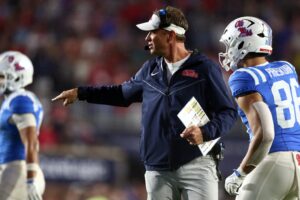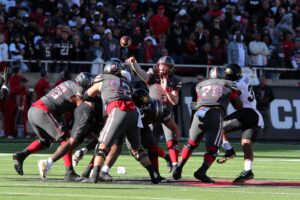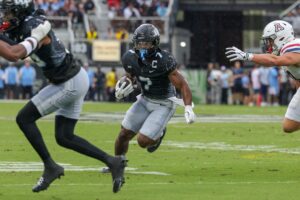Every season, we begin our coverage of the West Virginia Mountaineers by making several predictions. Who will be the surprise performers on offense? What about defense? How will the team fare as a whole? We frequently revisit these predictions during the season to keep ourselves honest. Thus, as the Mountaineers enter their second bye week, we are assessing the Mountaineers after three games.
Assessing the Mountaineers After Three
Assessing the Offense
Simply, through three, West Virginia has struggled on offense. Granted, they played two of the top three defenses in the conference (Baylor and Oklahoma State), but they too frequently stalled drives because of penalties and timing issues. There are, however, positive trends on this side of the ball (more on that in a moment). That said, the unit needs plenty of improvement for the team to remain competitive through the rest of the season.
Offensive Surprise Predictions
So far, several of our offensive surprise performers are falling short. Sam James leads the team with 17 receptions and stands second with 160 yards. We named his an offensive surprise under the assumption that he would improve his drop rate and at least eclipse his freshman-season totals (despite a shortened schedule). While early, those thresholds look difficult for James to meet. He still suffers from concentration issues at times, and he has dropped several critical passes as a result. This isn’t a knock on James, however. He still has plenty of time in his career, and the spotlight was thrust upon him by the attrition prior to the 2019 season. But we would like to see more, and we still think he will show more through the next seven games.
We predicted Bryce Ford-Wheaton would eclipse 500 receiving yards. Through three games, he has 108 with two touchdowns. With seven games to go, he will need to average 58 yards per game to meet our prediction. Should Doege find ways to move the ball downfield more efficiently, this prediction remains possible, if not likely.
We also predicted a critical offensive line role for sophomore Junior Uzebu. He faced a suspension for the season opener. But he also started and received the majority of snaps against Oklahoma State. But Brandon Yates retook his spot on the unit against Baylor, and Uzebu did not register a snap. We anticipated a true position battle throughout the season, so the job is still up for grabs. So plenty of opportunities remains for Uzebu.
Finally, we predicted Leddie Brown as a surprise player. So far, so good. Brown has put up two 100-yard games. He also racked up five total touchdowns through three games. Safe to say this prediction holds true.
Bold Prediction: Rushing Offense
After predicting some incremental, but important, improvement on the offensive line for this season based on a deep dive into attrition numbers and snap counts, we made a bold prediction about the run game. We predicted that a run game that produced only 73.4 rushing yards per game on a paltry 2.5 yards per carry in 2019 would improve by at least 50% and produce an average of 110 rushing yards per game.
So far, the Mountaineers produced the most rushing yards in a single game (329) since their 2016 season, with two 120-yard rushers in the opening win against Eastern Kentucky. Not accounting for sacks, which are applied to a team’s rushing stats on the college level, the Mountaineers followed that up with a 109-yard performance against a stout Cowboys defense. And they added 134 yards on the ground against Baylor. In total, they are averaging 177 rushing yards per game through three.
Assessing the Defense
In regulation, the Mountaineers’ defense surrendered 10 points, 20 points, and 14 points in their first three games. They also gave up 7 additional points to Baylor in overtime. Overall, the defense has allowed just 17 points per game (remember that the offense surrendered 7 against the Cowboys on a scoop-and-score). The unit also gave up only 268 yards per game through three. The effort is led by a menacing defensive line, some solid play at linebacker, and a secondary that has come into its own over the last couple of games.
Of our predicted surprises on this side of the ball, we hit the mark on four of five. We expected Daryl Porter to see playing time, and, so far, he’s earned 13 total snaps (all against Eastern Kentucky). Otherwise, our predictions hold well against on-field performance. Freshman All-American Tykee Smith looks even more dominant in his sophomore season, as he is third on the team with 18 tackles. He added a critical interception in the end zone against Baylor in the second overtime.
True freshman standout Akheem Mesidor has played on just under 30% of the team’s defensive line snaps (fourth-best for the unit). In that time, he contributed well, netting nine tackles (eighth on the team), two sacks (tied for second ), and two tackles for loss (tied for fifth). We certainly look forward to more dominant play from him.
We also hit our marks on Dreshun Miller and Tony Fields, so far. Miller has an interception and five tackles, and his coverage skills have proven invaluable to date. As for Fields, we wrote that his stat line would resemble those of West Virginia’s most recent NFL-caliber linebacker, David Long. Fields shows up around the ball on almost every play. So far, Fields racked up a team-high 29 tackles, two tackles for loss, a sack, and an interception.
Bold Predictions: Scoring Defense and an All-American
For the entire unit, we predicted the Mountaineers would finish as a top-three unit in the Big 12 in terms of points per game allowed. To date, West Virginia ranks second in the conference, behind only Oklahoma State. Only time will tell if that performance can continue, but all signs point to the affirmative. The Mountaineers, in fact, rank 14th in the entire nation in that category. And they get there honestly, surrendering the sixth-fewest yards per game to opposing offenses. Minor weaknesses are there, to be sure, but they are hard to find.
In fact, West Virginia’s All-American candidate, Darius Stills has not performed at his best yet this year. Yet he leads the team with two-and-a-half sacks and four-and-a-half tackles for loss. Dante Stills also has not yet hit his higher gears. Vandarius Cowan is still working himself back into every-down shape, so we also have not seen his best. Indeed, the biggest “weakness” on the defense remains simple: we have not yet seen the best individual performances for many on the unit. If Darius can continue the momentum his built against Baylor (all of his sacks came in that game), he can still earn an All-American nod. For now, that remains to be seen.
What About the Wins?
Our final preseason prediction focused on the ultimate goal: to get wins. Keeping in mind these are our bolder predictions meant to reflect our highest performance estimates, we predicted the Mountaineers to win seven games inclusive of bowl games. Assuming, of course, that teams complete a full season, we still think this is possible. Despite the offensive struggles, the stout defense certainly lends us a solid limb on which to climb. As it turns out, every team in the conference looks beatable, too.
Kansas State and Kansas both lost their season openers to teams from the Sun Belt Conference. The Jayhawks are, per usual, 0-3 to start. Kansas State, on the other hand, recovered and won back-to-back games against Oklahoma and Texas Tech. Texas Tech struggled to beat Houston Baptist in its season opener. TCU lost to Iowa State and beat Texas. Texas struggled to beat Texas Tech and then lost to TCU. Iowa State lost its season opener to Louisiana 31-14 but followed that up with wins against TCU and Oklahoma. Oklahoma, meanwhile, lost back-to-back games to Kansas State and Iowa State.
As a result, West Virginia could leave October 5-1 (at best) or 4-2 (at worst). At worst, West Virginia needs to split its four remaining games and win a bowl game to reach seven wins. Assuming the offense corrects its miscues, a 7-4 season starts to seem like a low watermark than a high-end estimate. But football is football, and 2020 has been wild. So anything can happen.






